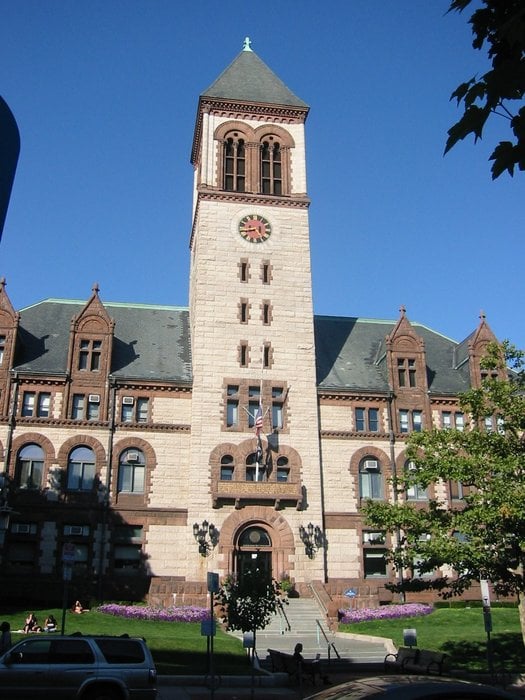– Perri M.
As we gear up for our February 7 book launch of A Planet to Win: Why We Need a Green New Deal (Verso, 2019: see event details below), we revisit our December 2019 talk with Dr. Billy Fleming, author of the Places journal article “Design and the Green New Deal.” Fleming, who is the Wilks Family Director at the McHarg Center at the University of Pennsylvania, was generous enough to join us on a cold and soggy Friday evening to discuss his recent work.
We share here a few highlights from his presentation and invite you to watch the full talk on the Boston DSA facebook page.
Fleming began his presentation by walking us through the key points of his Places journal article. Central to his thesis is that designers must dismantle the notion that design is an agent of power. Rather, Fleming interrogates how that power is structured—through capitalism and inequality—and implores designers to reflect on the ways they can align themselves with different social movements that want to restructure that power. In other words, when Fleming asks “Can a set of practices tied to luxury real estate deliver anything meaningful to communities impacted by global warming and inequality?”, he quickly responds, “A pretty obvious and resounding no.”
This argument builds on and is partially inspired by design critic Alexandra Lange’s critique of so-called “starchitect” Rem Koolhaus. Lange asks, ‘Could [Koolhaus] have used his stardom to refuse competitions, establish parameters for equitable practice, set a 40-hour workweek, not work in China and the Middle East? Maybe. Did he? No.” Applying that same sort of question to the design field at large, Fleming demands that designers utilize their resources—be it through a university or other institution—toward anticapitalist initiatives. Or, as Fleming does through his position at the McHarg Center, toward a Green New Deal.
While it derives its name from the 1930s New Deal, the Green New Deal must not identically replicate the FDR-era program, Fleming says. For instance, the New Deal reinforced policies of the Jim Crow South and forms of racial capitalism. It did not aim to dismantle capitalism; rather, the New Deal policies served to “save capitalism from itself,” according to Fleming. But policymakers and designers can use and build on the infrastructure developed nearly 100 years ago. Fleming showed examples from the Rural Electrification Administration, pointing out that a large percentage of power lines today emerged from massive installation efforts across the country in the 1930s. As policies of the Green New Deal continue to shape up, designers are in a position to take the existing building stock and restructure it for sustainable, equitable purposes.
Among the ways this can be realized is through the Green New Deal for Public Housing. Fleming is one of the coauthors of the Data for Progress’s policy research on public housing for H.R. 109 “Recognizing the duty of the Federal Government to create a Green New Deal.” sponsored by New York Representative Alexandra Ocasio-Cortez. Acting as a framework for action, H.R. 109 has the potential to radically transform a multitude of systems, including transportation, civic infrastructure, and agriculture. The fellows and researchers with Data for Progress demonstrate how the Green New Deal is feasible, and it excites us as they help us envision that another world is possible, apart from the ecologically destructive and socially irresponsible practices we currently endure domestically and internationally. Their policy research is only one of the avenues for engaging with the Green New Deal as it continues to develop.
Fleming also showcased maps predicting the impacts of climate change if radical changes are not made to our political, infrastructural, and economic systems. These maps are now available online as part of the McHarg’s Center’s 2100 Project: An Atlas for the Green New Deal.This impressive inventory of maps “brings a new degree of precision to the lucidity of our climate imaginary. They help us make sense of which outcomes are probable, which are possible, and they imply their own ideas about desirability in the process. And that winnowing of potential futures and choices can bring with it a sense of heightened certainty about how, when, and where things might unfold on a planet devoured by capitalism” (Source: The McHarg Center). For Fleming, these maps are just one of the tools that designers can offer toward dismantling capitalism, restructuring systems of power, and demanding a radical Green New Deal.
The presentation concluded with a lively Q&A, centered on questions about agroecology and regenerative agriculture; managing housing for climate refugees; decarbonizing the electric grid; and prioritizing regions such as Appalachia, the Mississippi Delta, and the cornbelt of the Midwest.
Many thanks to Billy Fleming for presenting his work and to all those who attended!
Please join the Boston DSA in welcoming Drs. Thea Riofrancos, Daniel Aldana Cohen and Alyssa Battistoni to Porter Square Books on February 7 as they launch their new book, A Planet to Win: Why We Need a Green New Deal.
Header Image:




Leave a Reply